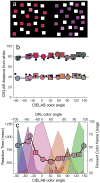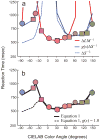Color channels, not color appearance or color categories, guide visual search for desaturated color targets
- PMID: 20713637
- PMCID: PMC3050514
- DOI: 10.1177/0956797610379861
Color channels, not color appearance or color categories, guide visual search for desaturated color targets
Abstract
In this article, we report that in visual search, desaturated reddish targets are much easier to find than other desaturated targets, even when perceptual differences between targets and distractors are carefully equated. Observers searched for desaturated targets among mixtures of white and saturated distractors. Reaction times were hundreds of milliseconds faster for the most effective (reddish) targets than for the least effective (purplish) targets. The advantage for desaturated reds did not reflect an advantage for the lexical category "pink," because reaction times did not follow named color categories. Many pink stimuli were not found quickly, and many quickly found stimuli were not labeled "pink." Other possible explanations (e.g., linear-separability effects) also failed. Instead, we propose that guidance of visual search for desaturated colors is based on a combination of low-level color-opponent signals that is different from the combinations that produce perceived color. We speculate that this guidance might reflect a specialization for human skin.
Conflict of interest statement
Figures



References
-
- Bauer B, Jolicoeur P, Cowan WB. Visual search for colour targets that are or are not linearly separable from distractors. Vision Research. 1996;36:1439–1466. - PubMed
-
- Bauer B, Jolicoeur P, Cowan WB. Convex hull test of the linear separability hypothesis in visual search. Vision Research. 1999;39:2681–2695. - PubMed
-
- Boynton RM, Kambe N. Chromatic difference steps of moderate size measured along theoretically critical axes. Color Research and Application. 1980;5:13–23.
-
- Carter RC. Visual search with color. Journal of Experimental Psychology: Human Perception and Performance. 1982;8:127–136. - PubMed
Publication types
MeSH terms
Grants and funding
LinkOut - more resources
Full Text Sources

